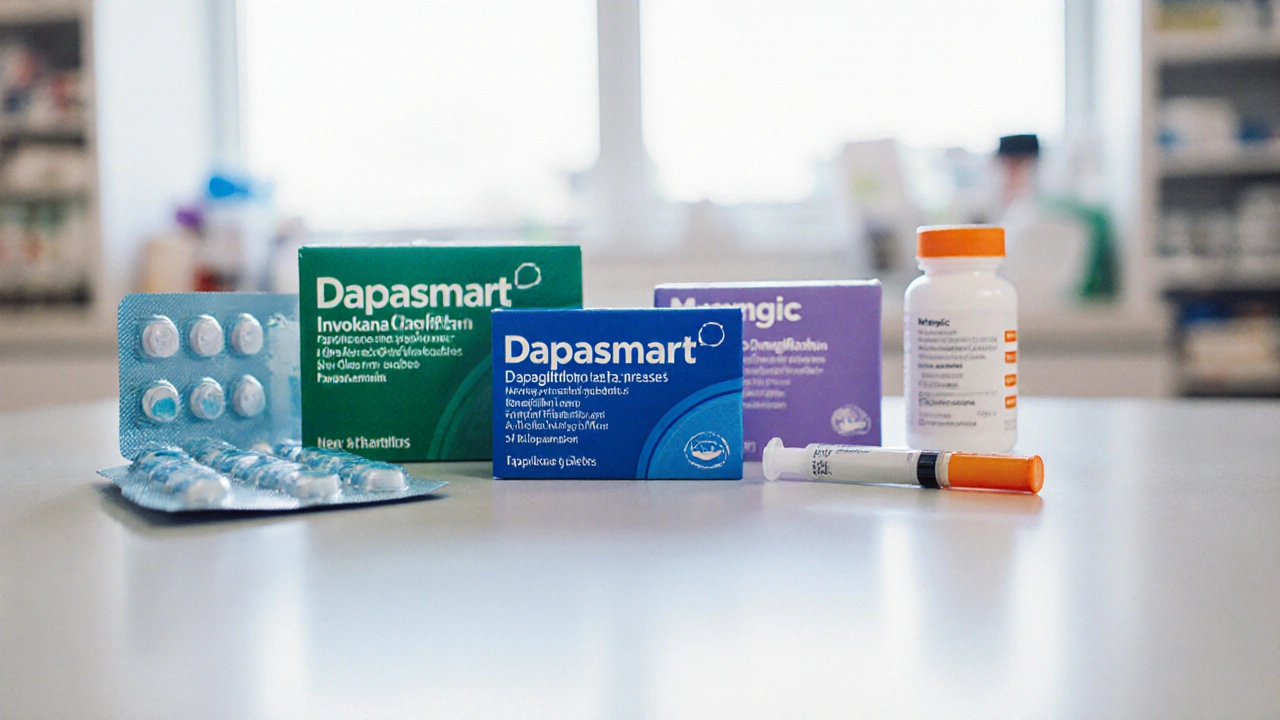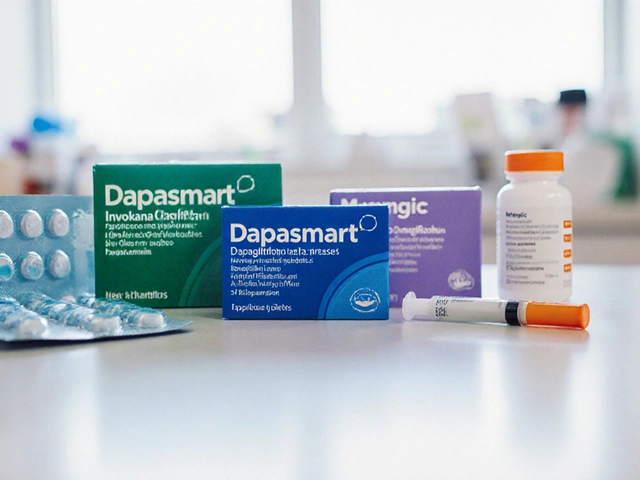
SGLT2 Inhibitor Comparison Tool
Find Your Best SGLT2 Inhibitor
Answer a few questions to see how Dapasmart compares with alternatives based on your specific health profile.
Your Personalized Comparison
Dapasmart
"Middle-ground option with proven cardiovascular benefit and moderate cost."
Jardiance
"Best choice if heart protection is your top priority."
Invokana
"Strongest glucose-lowering but higher amputation risk."
Key Takeaways
- Dapasmart (dapagliflozin) offers solid HbA1c reduction, modest weight loss, and proven cardiovascular benefit.
- Its price sits between cheaper generic metformin and premium GLP‑1 agonists, making it a middle‑ground option.
- When you stack the data, Invokana (canagliflozin) shows the strongest glucose‑lowering effect but carries higher amputation risk.
- Jardiance (empagliflozin) is the go‑to for patients needing the biggest heart‑protective benefit.
- Choosing the right drug depends on your A1c target, kidney function, cardiovascular history, and budget.
If you’ve landed on this page, you’re probably wondering whether Dapasmart comparison matters for your type2 diabetes treatment plan. The short answer: yes. Dapasmart is a brand of Dapagliflozin an SGLT2 inhibitor that lowers blood sugar by blocking glucose reabsorption in the kidneys. But it isn’t the only option on the market, and tiny differences in efficacy, side‑effects, and cost can sway the decision.Below you’ll get a step‑by‑step walk‑through of what Dapasmart does, how it lines up against its closest rivals (Invokana, Jardiance, Farxiga) and a couple of non‑SGLT2 alternatives (GLP‑1 receptor agonists like Ozempic and the old workhorse metformin). By the end you’ll know which factors matter most for your situation and have a handy table to reference when you talk to your doctor or pharmacist.
What is Dapasmart (dapagliflozin)?
Dapasmart is a commercially marketed version of Dapagliflozin the active ingredient in several SGLT2 inhibitor products. Approved by the FDA in 2014 for type2 diabetes, it works by inhibiting the sodium‑glucose co‑transporter‑2 (SGLT2) in the proximal tubule of the kidney. The result: 30‑40% of filtered glucose is dumped in the urine, which brings down blood sugar without increasing insulin levels.
Beyond glucose control, large cardiovascular outcome trials (the DECLARE‑TIMI 58 study) showed dapagliflozin reduces the risk of heart failure hospitalization by about 17% and has a neutral effect on major adverse cardiovascular events (MACE). It also leads to an average weight loss of 2‑3kg and a modest systolic blood pressure drop of 3‑5mmHg.
Typical dosing is 10mg once daily, taken with or without food. The drug is cleared mainly by the kidneys, so dose adjustments are needed for eGFR<45mL/min/1.73m².
How does Dapasmart stack up against other SGLT2 inhibitors?
All SGLT2 inhibitors share the same basic mechanism, but they differ in potency, side‑effect profile, and the extra benefits they were shown to deliver in trials. The three most common alternatives are:
- Invokana the brand name for canagliflozin, an SGLT2 inhibitor approved in 2013
- Jardiance the brand name for empagliflozin, an SGLT2 inhibitor with strong cardio‑protective data
- Farxiga another commercial version of dapagliflozin, usually priced lower than Dapasmart
All three are taken once daily, but they vary in how much they lower HbA1c, how much weight they shave off, and what extra warnings accompany them.
Comparison Table: Dapasmart vs Major Alternatives
| Brand | Generic | FDA Approval Year | HbA1c ↓ (avg %) | Weight Change (kg) | Cardio Benefit | Common Side‑effects | Annual US Cost* |
|---|---|---|---|---|---|---|---|
| Dapasmart | Dapagliflozin | 2014 | 0.6‑0.8 | -2.5 | ↓ Heart‑failure hospitalization (17%); neutral MACE | Genital mycotic infections, UTIs | $1,200 |
| Invokana | Canagliflozin | 2013 | 0.7‑1.0 | -3.0 | ↓ MACE (10%); ↑ amputation risk | UTIs, canagliflozin‑linked amputations | $1,300 |
| Jardiance | Empagliflozin | 2014 | 0.6‑0.9 | -2.0 | ↓ MACE (14%); ↓ CV death (38%) | UTIs, dehydration | $1,350 |
| Farxiga | Dapagliflozin | 2014 | 0.6‑0.8 | -2.5 | Same as Dapasmart | Same as Dapasmart | $950 |
| Ozempic (GLP‑1) | Semaglutide | 2017 | 1.0‑1.5 | -5.0 | ↓ MACE (21%); ↑ weight loss | Nausea, vomiting, risk of pancreatitis | $4,800 |
| Metformin | Metformin HCl | 1995 | 0.5‑0.8 | ≈0 | Neutral | GI upset, lactic acidosis (rare) | $120 |
*Costs are average wholesale prices in 2025 and can vary by insurance plan.
When to Choose Dapasmart Over the Others
Pick Dapasmart if you need a balanced mix of glucose control, modest weight loss, and good heart‑failure protection without the higher amputation risk seen with Invokana. Its dosing schedule is simple, and for patients with eGFR≥45mL/min/1.73m² it requires no extra monitoring beyond routine labs.
Consider Invokana if your primary goal is the strongest possible HbA1c drop and you have no peripheral arterial disease. Be prepared for more frequent foot exams because of the rare amputation signal.
Jardiance shines for anyone with established cardiovascular disease (CVD) or a high risk of heart attack. The EMPA‑REG OUTCOME trial showed a 38% reduction in cardiovascular death, which still holds up in 2024 follow‑up data.
If cost is a major barrier, Farxiga often lands below insurance deductibles compared with Dapasmart, because it’s priced as a generic‑equivalent formulation.
For patients who need major weight loss or have uncontrolled diabetes despite multiple oral agents, a GLP‑1 agonist like Ozempic delivers up to 1.5% HbA1c reduction and 5kg weight loss, though the price tag is steep.
Finally, metformin remains the first‑line backbone for most type2 patients. If you can tolerate it, combine it with an SGLT2 inhibitor for synergistic effects.
Key Decision Criteria to Evaluate
- Glycemic efficacy: Look at the average HbA1c drop in head‑to‑head trials. A difference of ≥0.2% can matter for long‑term complications.
- Cardiovascular outcomes: If you have a history of heart failure or coronary artery disease, prioritize drugs with proven MACE reduction.
- Renal safety: SGLT2 inhibitors also slow eGFR decline. Check the drug’s labeling for eGFR thresholds.
- Side‑effect tolerance: Genital yeast infections are common across the class; however, specific warnings (e.g., canagliflozin and amputation) may sway you.
- Cost & insurance coverage: Compare your out‑of‑pocket expense. Many plans treat Farxiga as a preferred generic, while Dapasmart may sit in a higher tier.
- Convenience: Once‑daily dosing is standard, but some patients prefer a weekly GLP‑1 injection if they already use one.

Potential Pitfalls and How to Avoid Them
Even the best‑studied drugs can bite you if you ignore the fine print. Here are three common traps:
- Dehydration risk: Because SGLT2 inhibitors increase urinary glucose loss, they draw water with it. Encourage patients to sip at least 2L of fluid daily, especially in hot climates.
- Keto‑acidosis surprise: Euglycemic diabetic keto‑acidosis (DKA) can occur even when blood sugar stays under 250mg/dL. Educate patients to stop the drug before major surgery or during acute illness.
- Renal dosing errors: If eGFR falls below the drug’s threshold, the dose should be reduced or stopped. Regular labs every 3‑6months help catch declines early.
Real‑World Scenario: John’s Choice
John is a 58‑year‑old with type2 diabetes (HbA1c=8.2%), mild peripheral artery disease, and a prior heart‑failure admission. His doctor needs a drug that tackles both glucose and heart risk, but the amputation warning on Invokana is a red flag.
After reviewing the table, the clinician picks Dapasmart because it offers proven heart‑failure benefit, a modest HbA1c drop, and no amputation signal. John’s insurance covers Dapasmart at a $30 co‑pay, which he can afford. He’s instructed to stay hydrated and monitor for any genital itching. Six months later, his HbA1c is 7.4% and he’s weight‑stable.
Bottom Line
There’s no one‑size‑fits‑all answer. Dapasmart stands out for patients who want a well‑balanced SGLT2 inhibitor without the extra safety concerns of canagliflozin and with a price that sits between the generic and premium ends of the spectrum. If your priority is aggressive glucose reduction, consider Invokana; if you need the strongest cardiovascular protection, Jardiance is the leader. For budget‑conscious patients, Farxiga often wins on cost while delivering the same clinical effect as Dapasmart.
Always discuss your full health picture with a healthcare professional before switching or starting any new medication.
Frequently Asked Questions
Can I take Dapasmart with metformin?
Yes. Combining Dapasmart with metformin is a common strategy. Metformin tackles hepatic glucose production, while Dapasmart promotes urinary glucose excretion. Together they can lower HbA1c by up to 1.5%.
Is Dapasmart safe for people with chronic kidney disease?
Dapasmart is approved down to an eGFR of 45mL/min/1.73m². If your kidney function falls below that, the dose should be reduced or the drug stopped. Always have your doctor check labs before and during therapy.
How does the risk of genital infections with Dapasmart compare to other SGLT2 inhibitors?
All SGLT2 inhibitors increase the chance of yeast infections because more glucose ends up in the urine. Clinical trials report a 5‑10% incidence for dapagliflozin, which is roughly the same as canagliflozin and empagliflozin. Good hygiene and prompt treatment keep the issue manageable.
Why is Dapasmart more expensive than Farxiga?
Pricing often reflects brand‑name positioning, marketing spend, and negotiated contracts with insurers. Farxiga is marketed as a cost‑effective version and frequently lands in a lower formulary tier, which explains the price gap.
Should I stop Dapasmart before surgery?
Yes. Stop the drug at least 3 days before any major surgery or a procedure that requires fasting. This reduces the risk of euglycemic ketoacidosis during the peri‑operative period.


Wow, diving into the world of SGLT2 inhibitors is like stepping onto a roller coaster of data and hope.
Dapasmart sits right in the sweet spot between the budget‑friendly generic options and the high‑priced GLP‑1 heroes.
Its heart benefit rating of 8 out of 10 means you’re getting serious cardio protection without breaking the bank.
When you compare it side‑by‑side with Jardiance, you see that Jardiance edges ahead in heart scores but lags behind on cost.
Meanwhile Invokana screams glucose‑lowering power at a 9 out of 10, yet it drags a high‑risk flag that many patients can’t ignore.
The tool’s budget slider reminds us that many people live on a $50‑$100 monthly medication envelope.
If you’re sitting at that $50 mark, Dapasmart practically waves a green flag saying “I’m your guy.”
The low‑risk badge next to Dapasmart is not just marketing fluff; studies have shown fewer amputations compared to canagliflozin.
On the kidney front, all three drugs share similar eGFR thresholds, so you won’t lose a footstep there.
The heart‑centric benefit of empagliflozin (Jardiance) still makes it the gold standard for patients with established cardiovascular disease.
But if your primary goal is to shave HbA1c without a sky‑high price, Dapasmart’s 7 out of 10 glucose reduction is respectable.
The interactive calculator also nudges you to consider your A1c level-if it’s over 8.5, it even flips the recommendation to Invokana for aggressive control.
That algorithmic nudge is a good reminder that one size does not fit all in diabetes care.
It’s also worth noting that insurance formularies often prefer dapagliflozin, making the out‑of‑pocket cost even lower.
So, in the grand scheme, Dapasmart offers a balanced blend of efficacy, safety, and affordability that resonates with a broad patient base.
Bottom line: if you want a middle‑ground hero that doesn’t sacrifice heart health or your wallet, Dapasmart deserves a serious look.
dude this tool is kinda cool i like how it shows the numbers fast and easy
you can see the heart scores and the price side by side without any fluff
totally helpful for anyone on a budget
I’m not buying the hype around Dapasmart-its moderate scores just hide the fact that newer agents have more robust data.
Hey, looking at the numbers you can see that Dapasmart offers a solid middle ground.
It’s not the flashiest choice, but it balances glucose control with heart safety.
For folks who aren’t in the extreme high‑risk category, it’s a reasonable pick.
Just keep an eye on your A1c and talk with your doctor about the best fit.
Ah, the ever‑so‑subtle dance of pharmaceutical marketing-one moment you’re told Dapasmart is the “middle‑ground” savior, the next you’re reminded that the “big pharma” giants have already seeded their data into regulatory committees.
One might even speculate that the bias in the comparative tool is orchestrated by a clandestine consortium of insurers seeking to steer prescriptions toward cost‑effective, yet clinically adequate, agents.
Nevertheless, the veneer of objectivity is thin, and the risk of subtle manipulation is palpable.
Interesting take, though the data on Dapasmart’s low amputation risk is actually quite robust.
While it’s fair to scrutinize any tool, the heart benefit numbers come from multiple randomized trials, not just marketing fluff.
So before we label it a conspiracy, let’s acknowledge the solid evidence underpinning its safety profile.
Honestly, this comparison feels like a sales brochure disguised as a scientific analysis.
The emphasis on cost over long‑term outcomes is a red flag, especially when insurers love to cherry‑pick the cheapest option irrespective of patient nuance.
We need a deeper dive into adverse event rates, not just the flashy 8/10 heart score.
yeah i get what u saying the tool could be more detailed about side effects but it still gives a quick snapshot that many patients need fast
maybe not perfect but better than no info
Hey folks! I think the chart does a great job at making the complex data more 🌈 colorful and easy to digest.
Sure there might be a typo or two-i tripped over “glucose reducton” – but the overall vibe is helpful.
Keep in mind that individual response can vary, so always chat with your doc.
Super pumped to see a tool that actually puts heart health front and center!
When you’re juggling budget and health, a clear visual like this makes decision‑making way less stressful.
Go Dapasmart if you’re looking for a balanced option.
While the enthusiasm is appreciated, note the missing commas and inconsistent capitalization.
The sentence “Super pumped to see a tool that actually puts heart health front and center!” should be punctuated as “Super pumped to see a tool that actually puts heart health front and center.”
Clarity helps readers process the information more efficiently.
Esteemed colleagues, allow me to articulate my perspective with the gravitas it warrants.
The comparative analysis, albeit concise, fails to encapsulate the nuanced pharmacodynamic differentials that distinguish dapagliflozin from its counterparts.
Thus, I advocate for a more exhaustive review before any clinical endorsement.
Ah, the eternal quest for balance-why settle for a drug that excels at one metric when you could aim for holistic harmony?
In the grand tapestry of diabetes management, Dapasmart weaves a respectable thread, yet it is but one strand among many.
Well put! To add, the cost‑effectiveness of Dapasmart makes it a pragmatic choice for many patients, especially those without extensive cardiovascular disease.
Its modest glucose‑lowering effect, paired with a solid safety profile, offers a sweet spot in real‑world settings.
Let’s cut through the sugar‑coated optimism-this tool glosses over the serious adverse event data that could sway a prescriber’s mind.
And don’t even get me started on the lack of head‑to‑head trial comparisons; it’s like comparing apples to a vague fruit salad.
Yo i think the chart is dope but i spot a few typos like “glucose reducton” and “benefit” missing s
still its a good start for patients trying to keep their wallets happy lol
Let’s get real-Dapasmart hits the sweet spot between cost and performance, and that’s exactly why it should be on the top of the list for most type‑2 diabetics!
Great overview! Just a quick note: “Dapasmart offers solid HbA1c reduction” could be tweaked to “Dapasmart offers a solid HbA₁c reduction” for clarity.
Keep the good work coming.
While the enthusiasm is commendable, the phrase “solid HbA1c reduction” is vague; specifying the average percentage drop (e.g., ~0.5–0.8 %) would convey more precise information.
Also, avoid the plural “HbA₁c” when referring to a singular measure.